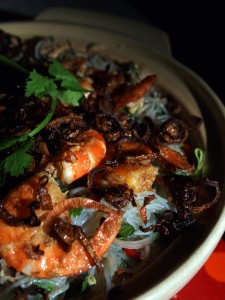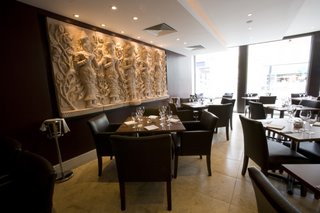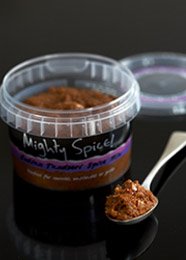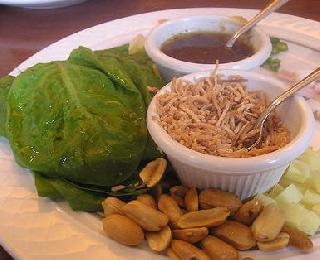 A friend complained the other week that there aren’t enough noodle recipes on this blog. So here, just for you, Andras, is a noodle salad.
A friend complained the other week that there aren’t enough noodle recipes on this blog. So here, just for you, Andras, is a noodle salad.
The noodles in this salad are glass noodles, made from mung beans (the same beans that beansprouts…sprout from). Don’t be tempted to substitute rice noodles, which have a very different texture. You’re unlikely to find glass noodles at your local supermarket, but any oriental grocer will carry them – they are sometimes marked “bean thread” or “pea thread” noodles. Check the packet – the only ingredient should be beans, or bean flour.
Texture’s all-important in this salad. The moist crunch of the lettuce against the dry crunch of crispy shallots, the slip of the noodles and the dense pieces of chicken and prawn all add up to a world-beating mouthfeel. A Thai-style dressing, with herbs, fish sauce, palm sugar, chillies and limes, gets the tastebuds in every part of your tongue working. We ate this as a main dish; it’s great as a side-dish too. For some reason, this is one of those recipes which demands to be eaten outdoors, so consider making it for a picnic or to serve at a barbecue.
To serve two to three as a main course or six as a side-dish, you’ll need:
8 large, raw prawns
2 chicken breasts, without skins
1 tablespoon tom yum paste
1 iceberg lettuce
100g glass noodles
1 handful (25g) coriander
1 handful (25g) mint
Juice of 4 limes
3 tablespoons fish sauce
2 teaspoons palm sugar (substitute soft brown sugar if you can’t find any)
1 red chilli
3 banana shallots
Stir the tom yum paste into the prawns and leave to marinade while you prepare the noodles (about 10 minutes).
Pour boiling water over the noodles to cover, and leave for 5 minutes until they are soft. Drain in a sieve, rinse in cold running water and transfer to a bowl. Use scissors to snip into the noodles so they are cut into pieces about an inch long. Cover and refrigerate.
Heat a tablespoon of oil in a very hot frying pan, and cook the prawns until pink. Remove to a bowl. In the same pan, which will have retained some of the paste, sauté the chicken until it is brown outside and cooked through. Remove to another bowl. Leave the prawns and chicken to cool while you prepare the crispy shallots and dressing – when you come to make the salad, they’ll be close to room temperature.
Slice two long shallots into very thin rings, and shallow-fry in a couple of centimetres of oil, stirring occasionally, until they are brown and sweet (10-15 minutes). Remove from the oil with a skimmer and drain on kitchen paper. Set aside.
Slice the third shallot in half lengthways, and chop very finely. In a bowl, mix it with the herbs, chopped very finely, the sugar, lime juice, fish sauce and finely chopped chilli. Stir the dressing into the chilled noodles. Chop the chicken into dice the size of the top joint of your little finger, and toss the pieces, along with any juices from the chicken, with the noodles.
Slice the lettuce, straight from the fridge, as thinly as possible, and lay it in the bottom of a large serving bowl. Cover with the noodle mixture, and arrange the prawns on top. Sprinkle the crispy shallots over the dish and serve, making sure that some of every layer makes it onto the plate.





